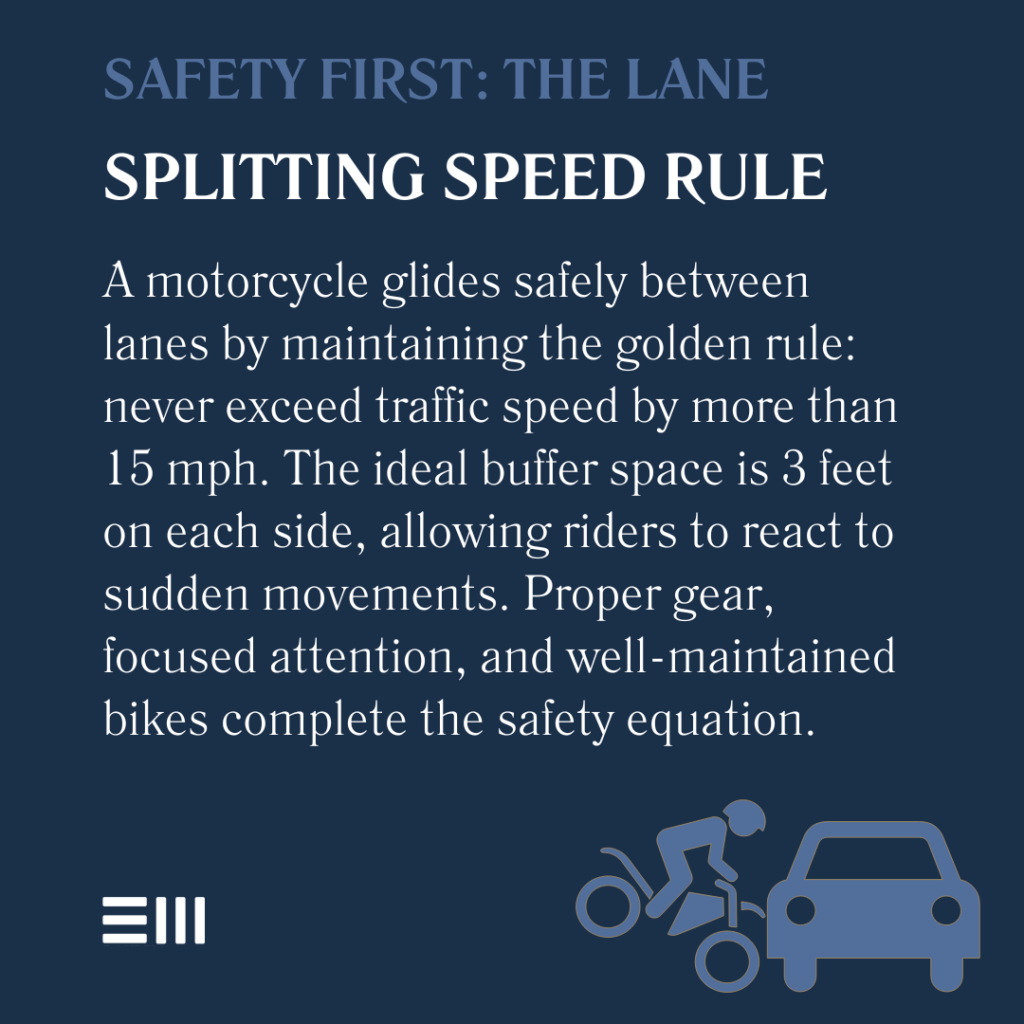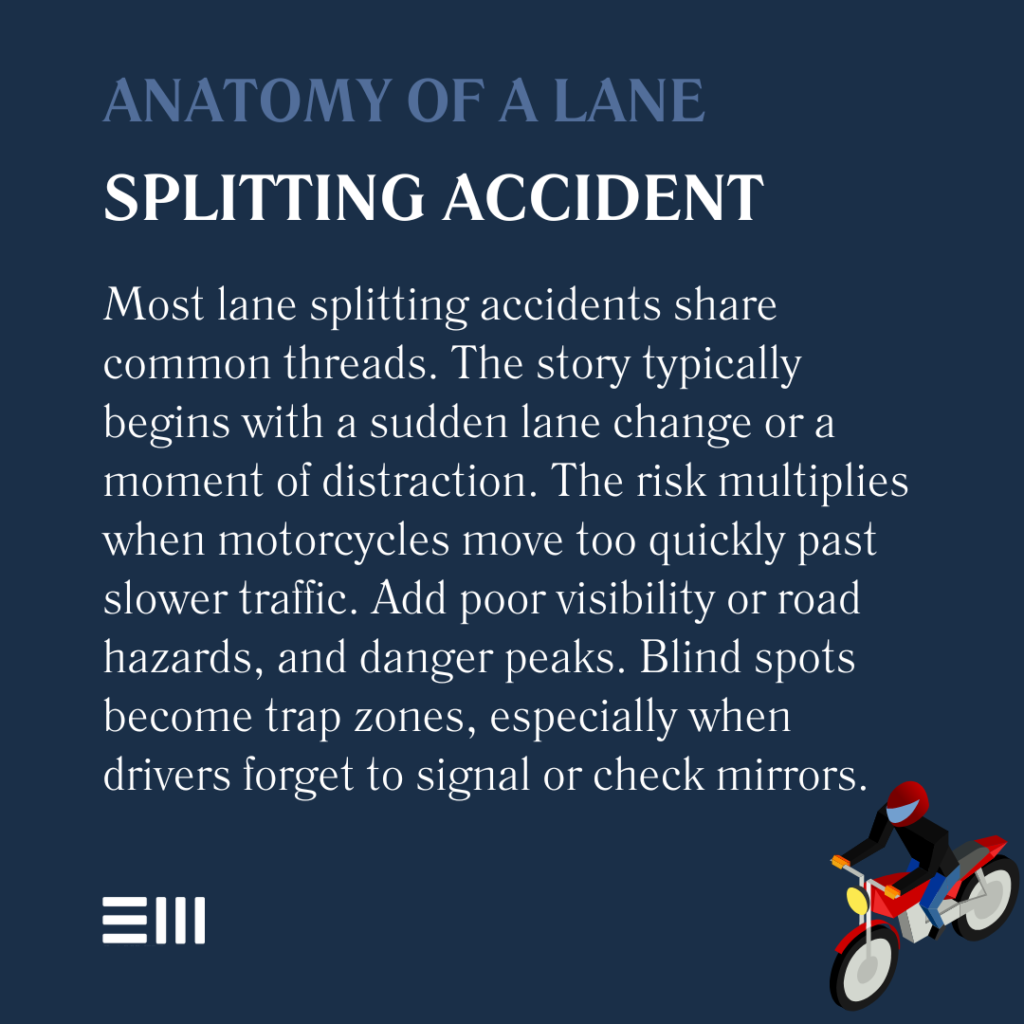
The rumble of motorcycle engines between lanes has become a familiar sound on Alabama’s highways. As riders thread their machines through the narrow spaces between cars, a complex dance unfolds between motorcyclists and motorists.
For some, lane splitting represents freedom and efficiency on congested roads. For others, it sparks concern about safety and responsibility.
Yet beneath these differing perspectives lies a shared goal: ensuring everyone makes it home safely at the day’s end.
Understanding Lane Splitting
Motorcyclists weaving between lanes of slow-moving or stopped traffic has become increasingly common on our roadways.
This practice, known as lane splitting, presents unique challenges and considerations for everyone sharing the road.
What Is Lane Splitting?
Lane splitting occurs when motorcyclists ride between lanes of traffic moving in the same direction. This differs from lane filtering, where motorcyclists move between stopped vehicles at traffic lights or in congested traffic.
The practice remains controversial, with varying legal status across different states.
Legal Status in Alabama
In Alabama, lane splitting is currently illegal and can result in traffic citations. However, motorcycle advocacy groups continue to push for legislation that would legalize and regulate this practice, similar to states like California.
Violations can result in fines of up to $200 and potential points on your driving record. Recent legislative efforts have focused on studying the safety implications and potential benefits of regulated lane splitting.
Safety Considerations for Riders
The decision to lane split carries significant implications for motorcycle safety. Understanding these factors helps riders make informed choices about their riding behavior.
Key safety factors include:
- Maintaining appropriate speed differentials (no more than 15 mph faster than surrounding traffic);
- Ensuring adequate space between vehicles (minimum 3 feet clearance);
- Being aware of blind spots and vehicle movements;
- Monitoring road surface conditions for hazards;
- Watching for sudden vehicle movements or lane changes;
- Maintaining heightened awareness during peak traffic hours;
- Using appropriate protective gear; and
- Ensuring motorcycle maintenance for optimal control.
Riders who choose to lane split must remain vigilant and practice defensive driving techniques at all times.
Studies show that proper training and experience significantly reduce the risk of accidents during lane-splitting maneuvers.

Motorist Awareness and Responsibilities
Creating a safer road environment requires active participation from all vehicle operators. Awareness of motorcycle presence and common riding practices can significantly reduce accident risks.
Essential awareness practices for motorists:
- Checking mirrors frequently (every 5-8 seconds in heavy traffic);
- Using turn signals consistently and well in advance of lane changes;
- Maintaining steady lane position without sudden movements;
- Avoiding sudden lane changes or merging without warning;
- Leaving adequate following distance (minimum 4 seconds);
- Reducing music volume to hear approaching motorcycles;
- Avoiding distractions like phone use or eating;
- Being especially vigilant during peak commuting hours; and
- Looking twice at intersections and before lane changes.
These practices help create predictable traffic patterns that benefit all road users. Regular mirror checks and signal use can prevent up to 80% of lane-splitting-related accidents.
Common Causes of Lane Splitting Accidents
Understanding the primary factors contributing to lane-splitting accidents helps both motorcyclists and motorists prevent dangerous situations.
Data from traffic safety studies reveals patterns in accident causation.
Major accident causes include:
- Sudden lane changes by vehicles without signaling;
- Excessive speed differential between motorcycles and traffic;
- Inadequate space between vehicles for safe passage;
- Poor visibility conditions (weather, lighting, or blind spots);
- Distracted driving (phone use, eating, or adjusting controls);
- Road surface hazards (potholes, debris, or oil slicks);
- Improper motorcycle maintenance;
- Rider fatigue or impairment;
- Aggressive driving behavior; and
- Failure to check blind spots.
Recognizing these risk factors allows road users to adjust their behavior accordingly and maintain safer driving practices.

Prevention Strategies
Implementing effective prevention strategies reduces the likelihood of lane-splitting accidents and promotes safer road conditions for everyone. Safety experts recommend a comprehensive approach to accident prevention.
Recommended prevention measures:
- Regular mirror checks and blind spot monitoring;
- Maintaining consistent lane positions without drifting;
- Using turn signals early and consistently;
- Avoiding all forms of distraction while driving;
- Maintaining appropriate following distances;
- Practicing situational awareness at all times;
- Installing blind spot detection systems;
- Keeping vehicles properly maintained;
- Taking advanced driving courses; and
- Using motorcycle-specific safety gear.
Consistent application of these strategies creates a more predictable and safer road environment.
Frequently Asked Questions About Lane Splitting and Motorcycle Safety in Alabama
Understanding the complexities of lane splitting and motorcycle safety often raises important questions.
These answers address the most common concerns of both riders and motorists.
What Are the Current Laws on Lane Splitting in Alabama?
Lane splitting remains illegal in Alabama, with potential fines and penalties for violations. Current state law requires motorcycles to occupy a full lane and follow the same traffic rules as other vehicles. Penalties can include fines, points on your license, and increased insurance rates.
How Can Drivers Better Share the Road with Motorcyclists?
Drivers should maintain consistent lane positions, use turn signals, check blind spots frequently, and avoid sudden movements. Creating predictable traffic patterns helps motorcyclists navigate safely. Regular mirror checks and maintaining appropriate following distances are essential.
What Should I Do After a Lane Splitting Accident?
Ensure everyone’s safety, document the scene, gather witness information, and seek medical attention if needed. Contact law enforcement to file an accident report and consider consulting with a legal professional. Preserve all evidence, including photos, videos, and witness statements.
When Is Lane Splitting Most Dangerous?
Lane splitting risks increase during heavy traffic, poor weather conditions, limited visibility, or when speed differentials between motorcycles and other vehicles exceed 10 mph. Dawn and dusk hours present additional visibility challenges.
What Insurance Considerations Apply to Lane Splitting Accidents?
Insurance claims involving lane splitting can be complex due to its illegal status in Alabama. Coverage may be affected by the circumstances and determined fault in the accident. Consulting with an experienced motorcycle accident attorney can help protect your rights.
Take Action for Your Safety and Rights
When motorcycle accidents happen, having experienced legal guidance can make a critical difference in protecting your rights and securing fair compensation.
Our team understands the unique challenges of lane-splitting cases and stands ready to help you navigate the complex legal landscape.
Can't find what you're looking for? Search our site below.










